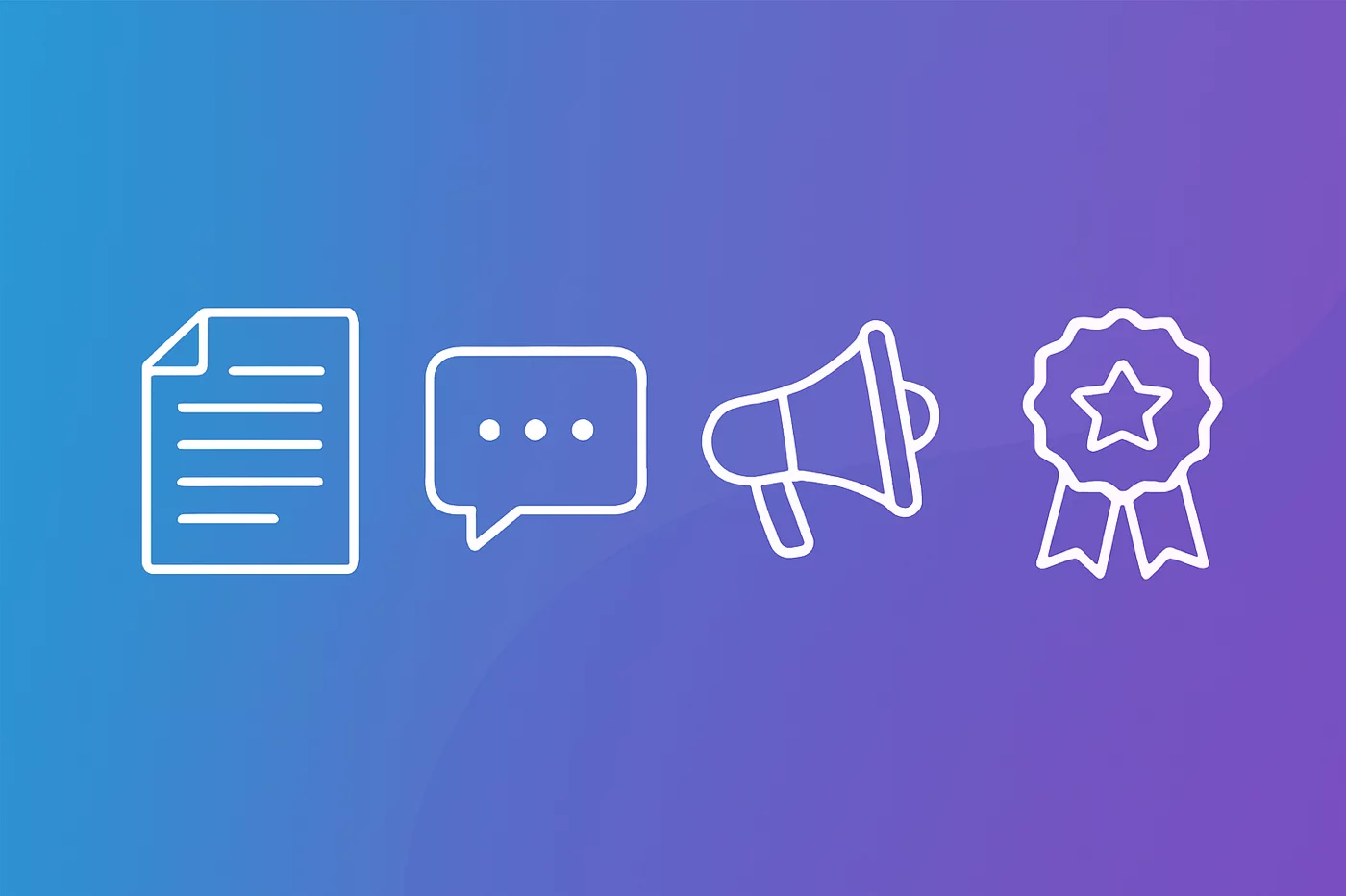Resources
Stay updated with our latest insights on AI, Case Studies, and explore deep dives into the science behind Ask Aura's coaching model

DevX.com's 16 Initiatives That Empower Employees and Make a Difference
This comprehensive guide explores 16 powerful initiatives that transform workplace dynamics and empower employees to drive organizational success. Leading experts share practical approaches for creating environments where teams can innovate without unnecessary constraints or micromanagement. These field-tested strategies connect individual contributions to broader company goals while fostering the psychological safety essential for meaningful innovation.Protected Innovation Time Creates Psychological Safety Community Solutions Fund Empowers Frontline Innovation Quarterly Innovation Time Creates Meaningful Impact Client Champions Turn Employees Into Mini-CEOs Build Weeks Foster Initiative Without Permission CommitBot Tracks Progress Without Micromanagement Empower to Impact Transforms Ideas Into Outcomes Trust Smart Hires Instead of Micromanaging Founder’s Mindset Program Drives Practical Improvements Cost Visibility Empowers Engineers to Own Results Pilot and Prove Method Removes Fear Strategic Visibility Connects Efforts to Company Goals Innovate & Elevate Streamlines Client Documentation Freedom Within Frameworks Accelerates Feature Development Pitch Innovation Week Adapts to Market Uncertainty Case Studies Demonstrate Team ImpactRead more here.
DevX.com

Grit Daily: Building a Strong Company Culture: Advice from Founders
Creating a strong company culture requires intentional design and consistent implementation according to leading founders and CEOs. Industry experts share practical strategies for establishing values, building aligned teams, and developing systems that reinforce cultural priorities. These insights offer actionable approaches to culture-building that can be implemented from day one through a company’s growth stages. Define Your Non-Negotiables and Live Them Daily Create Space for People to Own Their Work Prioritize Culture Setting Before Product Development Establish Clear Cultural Guardrails From Day One Culture Forms Through Small, Everyday Moments Begin With Small, Consistent Communication Practices Align Core Values With Your Founding Team Build Culture Through Questions and Active Listening Start With Clarity on Values and Expectations Wire Observable Behaviors Into Company Systems Keep People at the Center of Systems Translate Vision Into Practical People Strategy Early Build a Team That Shares Values and Principles Include Team Members in Defining Core Values Treat Culture Like a Product That Needs Iteration Research What Works Through Soft Launch Approach Recruit Leaders Who Embody Your Desired Culture Define Core Values Before Making First Hire Read more here.
Greg Grzesiak

HR Vendor News: 16 Employee Retention Strategies
Employee retention during times of change requires strategic approaches backed by proven methods. Industry experts reveal that transparent communication, structured mentorship, and results-driven flexibility are essential components for maintaining team cohesion through uncertainty. This comprehensive guide examines sixteen evidence-based strategies that organizations can implement immediately to strengthen employee loyalty and reduce turnover.Open Communication With Feedback Loops Prevents Departures Radical Transparency With Personalized Communication Works Loyalty Beats Strategy in Team Retention Consistent Check-ins Create Culture During Crisis Regular Feedback Cycles Anchor Recognition Efforts Collaborative Problem-Solving Builds Meaningful Ownership Micro-Wins Boost Morale During Challenging Times Results-Driven Flexibility Empowers During Change Team Ownership Transforms Uncertainty Into Investment Stay Interviews Provide Valuable Retention Insights Virtual Communication Channels Maintain Team Cohesion Regular Individual Meetings Foster Authentic Connection Structured Mentorship Programs Strengthen Organizational Bonds Emotional Intelligence Addresses Underlying Employee Concerns Context, Clarity and Compassion Drive Trust Build Trust Through Transparent CommunicationRead more here.
HR Vendor News

Reimagining the Weekly 1:1: A Key to Unlocking Employee Growth
The Most Ignored, Yet Most Important Meeting of the Week Let’s be honest—how do you feel about your weekly 1:1? Probably not excited, right? For most of us, it’s just another meeting on the calendar. A quick status update, some polite feedback, and you both move on. But what if that meeting is actually the most powerful tool in your leadership toolkit? When done right, 1:1s are not just about project updates. They’re where real growth happens—where feedback lands, careers get shaped, and engagement grows. HRD Connect highlights that 89% of managers and 73% of employees believe 1:1s directly improve team performance. So why are we still treating them as an afterthought? The Problem with Traditional 1:1s 1:1s have become stale. They’ve turned into obligatory meetings rather than opportunities for meaningful development. Currently, these meetings often focus on past performance, giving feedback that feels more like judgment than growth. And while this might help managers track progress, it fails to motivate employees. In fact, Gallup reports that only 31% of U.S. employees are engaged in their work, the lowest in a decade. Here’s what ineffective 1:1s look like:Rushed: Managers squeeze them in between other meetings. Reactive: Only addressing immediate issues, no talk of future development. Vague: Lacking clear goals or direction. Demotivating: Without real follow-up, these meetings can hurt morale and performance.Why does this happen? Managers are overwhelmed with tasks and don’t have the time or tools to make these meetings effective. Employees often don’t know what to bring, making the meeting feel awkward and unproductive. The worst part? These meetings often get pushed or canceled—another sign that career development isn't a priority. Turning 1:1s Into Growth Conversations If your weekly 1:1s are just status updates, you’re missing the real opportunity. The true power lies in career development. Here’s the data:Gallup found that 80% of employees who received meaningful feedback in the past week were fully engaged. Culture Amp reports that regular 1:1s dramatically improve an employee’s ability to discuss career aspirations. For millennials, growth and development in a job are top priorities.When managers understand where their employees want to go and help them create a plan to get there, the impact is profound. Engagement increases, loyalty deepens, and productivity rises. A growth-focused 1:1 can give employees:Clarity on career direction Time to voice ambitions, blockers, and concerns Space to focus on skill development A partner in their manager, not just a taskmasterManagers, meanwhile, gain insight into employee satisfaction and career goals, which helps prevent burnout or turnover before it happens. The ROI of Growth-Centric 1:1s It’s simple: career-focused 1:1s pay off. When these meetings shift away from task updates and toward growth discussions, both employees and companies see the benefits.Employees are 3.6x more likely to be motivated when they receive ongoing feedback, especially when it’s focused on growth. Gallup found that 84% of employees who receive relevant, constructive feedback are engaged in their work. Employees who have regular career conversations are 2.9x more likely to be engaged.Now, consider this:Only 21% of employees say their performance is managed in a way that motivates them to excel. High-engagement teams show 21% greater profitability and 17% higher productivity.Here’s the key: while most 1:1s focus on immediate tasks, growth-focused 1:1s ask the important questions:What skills are you focused on this quarter? Are there stretch projects you’d like to take on? Where do you want to be in 12 months, and how can I help?This type of leadership builds momentum. It shows employees that their long-term goals matter. And that’s a huge win for the bottom line. How to Fix Your Weekly 1:1 (Without Burning Out) Here’s a simple structure for a high-impact 1:1: Quick Catch-Up (5-10 minutes)Personal check-in to gauge well-being and work-life balance. Discuss immediate tasks or blockers and any support needed.Development Focus (20-25 minutes)Talk about long-term career goals and aspirations. Identify skill gaps and opportunities for growth. Set actionable steps for development.Feedback & Recognition (5-10 minutes)Provide constructive feedback. Acknowledge achievements and progress. Discuss personalized learning paths.And most importantly, write it down. Follow up on the action items, track progress, and hold both parties accountable. Building a Culture of Growth When you shift the focus of 1:1s to career development, the impact is far-reaching. Not only do employee engagement and trust increase, but growth becomes an integral part of your company’s culture. And if you’re looking for the right tools to make this shift, Ask Aura is here to help. Our tool helps make these conversation easier. With insights on your employees, you'll know what motivates them and what they value in their work. You'll also understand how to communicate with them in way that lands. The weekly 1:1 doesn’t need to be a task-tracking session. It should be a career-building conversation. When you focus these meetings on development and growth, everyone wins. Employees stay engaged, managers build stronger relationships, and your business thrives. It’s not just about the meeting—it’s about creating an environment where growth is part of the daily rhythm. And if you need the tools to make this happen, Ask Aura has got you covered.
Admin

Employee Retention Strategies: How to Empower Managers
Employee Retention Strategies: How to Empower Managers Employee retention challenges require strategic approaches that empower managers to create lasting impact. This comprehensive guide brings together best practices and expert insights on transforming management roles from task supervisors to culture builders. From implementing stay interviews to creating meaningful mentorship programs, these actionable strategies help organizations foster environments where teams thrive and talent remains engaged.Integrate AI-Powered Coaching Into Daily Work Implement Three Simple But Powerful Practices Train Managers With Stay Interview Tools Foster Top-Down Empowerment With Total Commitment Implement Care Circles for Well-Being Focus Transform Managers From Task Directors to Environment-Shapers Make Managers Listeners Who Take Action Build Manager Engagement Through Transparent Communication Give Ownership of Team-Level Engagement Activities Establish Structured Mentorship Programs That Matter Create Employee Spotlighter Program for Values Recognition Equip Managers With Career Growth Conversations Create Retention Ownership Scorecards With Coaching Notice and Guide Team Growth Opportunities Give Managers Full Responsibility for Team Culture Encourage Active Role in Individual Development Leverage Employee Feedback for Improvement GoalsIntegrate AI-Powered Coaching Into Daily Work Managers are the ones who have daily visibility into their teams; yet they’re often underprepared and overextended when it comes to leading in ways that foster engagement. The key is not only to involve managers in retention efforts but to equip them with the tools and insights that make those efforts impactful. One approach we’ve taken is integrating AI-powered coaching into the flow of work. For example, rather than sending managers off to a one-time leadership workshop that gets forgotten a week later, we use AI coaching to give them bite-sized, personalized nudges in real time — things like conversation prompts for weekly 1:1s, guidance on recognizing team wins, or reminders to check in on career development goals. A recent example: middle managers were struggling with high turnover among early-career sales employees. By layering in AI coaching, we helped managers shift their weekly 1:1s from task updates to career conversations. The AI suggested specific questions tied to each employee’s strengths and ambitions, such as, “What stretch project would help you build the skills you want this quarter?” Engagement scores jumped, and within six months, voluntary turnover in those teams dropped by double digits. When you give managers AI-enabled tools to turn everyday moments into growth conversations, the workplace becomes stickier, more motivating, and far harder for employees to want to leave. Read more here.
HR Vendor News

From Chaos to Cohesion: Gen Z, Millennials & the Power of Purposeful Collaboration
Work has changed. Work will continue to change. What won't change is the need to work with others effectively ... because when teams work, work just works better. As workplace dynamics continue to evolve, collaboration has become the cornerstone of success in diverse and multigenerational teams. Gen Z and Millennials—known for their technological savviness and appetite for meaningful growth opportunities—are shaping a new era of workplace culture. Here’s how organizations can foster stronger collaboration and communication while catering to these generations' distinct values and aspirations. Why Team Collaboration is Important No team operates in isolation. In fact, many businesses are supported by distributed teams spread across different states or even around the world. According to a study conducted by the Institute for Corporate Productivity and Rob Cross, the Edward A. Madden Professor of Global Business at Babson College, high-performance organizations are up to 5.5x more likely than lower-performers to incentivize individual, team, and leader effectiveness in collaboration. The study of more than 1,100 companies—two-thirds of which include collaboration as a stated organizational value—found that the difference between productive and unproductive collaboration can be summed up in one word: purpose. It’s the purposeful pursuit of collaboration that is the primary reason high-performance organizations, such as Patagonia, one of four companies highlighted in the study, can leverage collaboration to achieve desired business outcomes. Effective collaboration results from an effective company culture that is supported by management and embraces the entire organization. Simply think about the best team of which you’ve ever been a part. What made that team work? Was it the project? The people? The interpersonal dynamics? Did you enjoy being part of it? Did it bring out the best in you? Now think about the worst team you’ve ever been on. What made those experiences different? Collaborative teams equal enhanced productivity and results. When teams work, they work in the best of ways. But teamwork takes effort, and the reality is that teams can fall apart, break down and experience disruption for myriad reasons. Understanding Generations in the Workplace When managed well, generational diversity is a superpower. Research shows that multigenerational teams are more innovative, more effective at problem solving, and stronger in mentorship. In fact, organizations that embrace generational diversity see a 30% boost in innovation outcomes and improved knowledge transfer across age groups (Visier Workforce Trends 2025). With generational intelligence — the ability to understand and lead across generations — managers can turn diversity into strength. Here’s how: ✅ Understand What Each Generation ValuesGen Z (born 1997-2012): Crave authenticity, constant feedback, flexibility, and purpose-driven work. They're digital-first but want meaningful, real-world mentorship. Millennials (1981-1996): Value collaboration, growth opportunities, and work-life balance. They’re adaptable but demand inclusion and autonomy. Gen X (1965-1980) and Boomers (1946-1964): Offer deep experience, prefer clear structure, and prize independence — but can feel sidelined by rapid change.✅ Adapt Your CommunicationUse multiple channels — asynchronous tools (Slack, Gmail, Outlook), as well as real-time chat, and face-to-face moments — to meet everyone where they are. Balance speed and thoughtfulness. Gen Z loves instant feedback; Boomers may prefer more deliberate discussions.✅ Facilitate Team AlignmentRun team sessions on communication preferences, working styles, and collaboration norms. Build mutual understanding rather than assumptions. Recognize and celebrate generational strengths: Gen Z's creativity, Millennials’ team spirit, Gen X's pragmatism, Boomers' wisdom. Figure out how to incorporate those generational strengths into your team sessions and leverage them in project planning and execution.✅ Lead with Empathy and CuriosityAsk your people what they need, instead of guessing. Generational divides often melt when managers show genuine interest.✅ Foster Cross-Generational CollaborationPair Gen Z employees with more experienced mentors for two-way learning. Gen Z brings fresh tech-savvy ideas; Boomers and Gen X offer industry wisdom. Create innovation pods that blend generational perspectives to tackle challenges from different angles.✅ Create Inclusive Team Norms: Don’t assume everyone shares the same unspoken rules about meetings, feedback, or decision speed. Instead, co-create team agreements:How will we handle disagreements? How often do we want real-time vs. async updates? What’s our approach to deadlines and flexibility?When everyone agrees on how work gets done, cultural and style differences become assets, not obstacles. ✅ Watch for "In-Group" Dynamics: In hybrid teams, it’s easy for in-office employees to get more visibility while remote workers feel left out. Similarly, dominant cultural or language groups can unintentionally overshadow others.As a manager, be proactive about pulling in remote voices and making space for quieter team members. Rotate leadership of meetings and spotlight contributions from across locations and backgrounds.The payoff? Research shows that teams led by generationally intelligent managers experience higher engagement, stronger innovation, and lower turnover. In fact, when managers lead with flexibility as well as cultural and generational intelligence, they unlock real business gains:More creative problem-solving (thanks to diverse input) Faster, smoother collaboration (fewer misunderstandings) Higher engagement and retention (people feel seen and valued)Visier’s data confirms it: teams with culturally intelligent leadership not only outperform on business metrics but also report higher employee well-being and lower burnout. In today’s workplace, the ability to flex — across cultures, locations, and working styles — is no longer optional. It’s the defining skill of the successful modern manager. As workplace diversity grows — not just in background but in ways of thinking and working — mastering generational intelligence isn’t optional. It’s the new baseline for every manager who wants to build a connected, future-ready team. Driving Results Through Collaboration By embracing the values and expectations of Gen Z and Millennials, organizations can unlock a new level of collaboration. When companies prioritize learning, growth, and meaningful engagement, these generations are empowered to lead innovation and drive success. For more tips and tools on mastering collaboration with Gen Z and Millennials, explore additional insights in our article, 5 Key Strategies for an Effective L&D Program.
Admin

How to Build Consensus and Secure Team Buy-in On Decisions
Consensus is built through trust, transparency, and ensuring every voice carries weight in the conversation. The most effective technique I've found is framing decisions around shared goals, rather than just top-down directives. When people understand why a decision matters and how it connects to their own success, buy-in follows more naturally. One practical approach is what we call the "listen-first loop." Before finalizing a decision, managers are encouraged to gather input through one-on-one meetings, pulse surveys, or team discussions, and then reflect that feedback to the group. Even if not every idea makes it into the final plan, employees see their input reflected in the outcome. That sense of ownership transforms the dynamic from compliance to commitment. AI coaching has been a game-changer here. For example, we've seen managers use AI-driven prompts that guide them on how to ask better questions during team discussions ("What's one potential downside we might be overlooking?" or "How could this decision make your work easier or harder?"). By quickly surfacing diverse perspectives, the team feels heard, blind spots are addressed, and consensus is reached with less friction. To read more, click here.
Small Biz Leader

TechBullion: ROI of Professional Development: Innovative Metrics for Small Businesses
Professional development is a critical investment for small businesses, but measuring its impact can be challenging. This article presents innovative metrics to evaluate the return on investment in employee growth and learning. Drawing from expert insights, these strategies offer practical ways for small businesses to quantify the benefits of professional development and link it directly to business success. Track Behavioral Outcomes in Work Flow Measure Upskilling Velocity for Impact Link New Skills to Revenue Growth Implement Time-to-Impact Measurement Strategy Monitor Skill Application in Live Projects Gauge Client Perception of Improvement Integrate Learning into Client Projects Assess Quality-to-Placement Ratio for Recruiters Calculate Skill Dividend for Tangible Results Tie Professional Development to Commission Growth Connect Training to Client Acquisition Metrics Evaluate Business Growth Through HR Expertise Observe Talent Impact on Operational Stability Monitor Client Retention and Lifetime Value Quantify Performance Improvements Post-Training Measure Content Velocity and Backlink Acquisition Link Development Programs to Customer Satisfaction Track Process Efficiency Improvements Post-Training Read more here.
TechBullion

Ask Aura Named Best Employee Development Tool of 2025
MIAMI, FL—September 25, 2025 - Humantelligence, a leading provider of AI workplace solutions, announced its latest recognition. Ask Aura™ has been named Best Employee Development Tool 2025 as part of Corporate Vision Magazine's Education & Training Awards program. Ask Aura is a breakthrough in personalized, real-time workplace coaching designed to help organizations unlock the full potential of their teams and foster stronger collaboration, leadership, engagement and productivity. Ask Aura combines the power of psychometric science with generative AI to provide employees with instant, context-aware guidance on leadership, communication and team dynamics—right within the flow of work. The AI coaching agent becomes especially relevant as companies adopt Microsoft Copilot. Ask Aura complements the tool, taking Copilot insights to the next level with more personalized GenAI insights for individuals and teams. Whether it’s understanding how to motivate a teammate, navigate interpersonal conflict, or adapt to a new role, Ask Aura delivers smart, empathetic, and tailored advice in real time. With top organizations, such as Accenture, Coca-Cola, HSBC Bank, EY, Honeywell and Cigna, piloting the solution, and industry leaders like BASF, AFLAC, Bank of the West and Ashley Furniture already leveraging Humantelligence’s platform, Ask Aura is poised to redefine how companies approach leadership development and employee engagement. This is especially critical as global employee engagement drops to its lowest levels in years. Gallup’s 2025 State of the Global Workplace report reveals that manager engagement has declined more than any other job category—dropping from 30% to 27%—while manager effectiveness has also plunged. With 70% of employee engagement tied directly to managers, this engagement crisis threatens the productivity and performance of entire organizations. Ask Aura addresses this head on, delivering real-time, personalized coaching and collaboration guidance— right where teams work. “We're thrilled to be recognized with this Education & Training Award. We built Ask Aura for the modern workforce, where managers and their teams are stretched thin and employees crave more meaningful connection, growth and engagement,” said John Betancourt, CEO of Humantelligence. “It’s time to equip every manager and team member with smart, 24/7 coaching. Ask Aura is their always-on, AI-powered coach, guiding communication and leadership moments directly in the flow of work, before bottlenecks or interpersonal conflict become problems.” Ask Aura Key Features:Instant, 24/7 guidance for managing team dynamics, communication, feedback, conflict resolution and onboarding Contextual, personalized insights powered by psychometric science and generative AI Seamless integration with Microsoft Teams, Outlook, Slack, and Zoom Voice-enabled and multilingual access available across devices Enterprise-ready with SOC 2, GDPR, and CCPA complianceAsk Aura is the first talent management AI agent that enhances, not replaces, people—making work more human. Designed to increase emotional intelligence and deepen human connections, the tool empowers leaders and employees alike with real-time coaching and development. Always on and accessible 24/7, it strengthens leadership skills, improves team dynamics and fosters meaningful engagement across your entire workforce, employee by employee. From conflict resolution to onboarding and retention, the goal is simple: turn every employee interaction into a moment of growth, collaboration and impact.
Admin